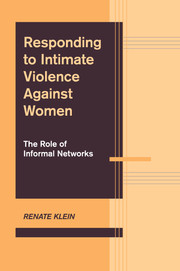Crossref Citations
This Book has been
cited by the following publications. This list is generated based on data provided by Crossref.
Klein, Renate
2013.
Framing Sexual and Domestic Violence through Language.
p.
163.
Klein, Renate
2013.
Post-secondary Education Responses to Forced Marriage and Gendered Abuse Against Students.
Children Australia,
Vol. 38,
Issue. 4,
p.
162.
Hydén, Margareta
2015.
What Social Networks Do in the Aftermath of Domestic Violence.
British Journal of Criminology,
Vol. 55,
Issue. 6,
p.
1040.
Sandberg, Linn J
2016.
“Love the kin you’re in?”: Kin network responses to women and children experiencing intimate partner violence.
Feminism & Psychology,
Vol. 26,
Issue. 4,
p.
444.
Sandberg, Linn
2016.
Response Based Approaches to the Study of Interpersonal Violence.
p.
98.
Sandberg, Linn
2016.
Being there for my grandchild – grandparents' responses to their grandchildren's exposure to domestic violence.
Child & Family Social Work,
Vol. 21,
Issue. 2,
p.
136.
Hydén, Margareta
2016.
Response Based Approaches to the Study of Interpersonal Violence.
p.
77.
Åkerlund, Nina
2017.
Caring or Vulnerable Children? Sibling Relationships When Exposed to Intimate Partner Violence.
Children & Society,
Vol. 31,
Issue. 6,
p.
475.
Gregory, Alison Clare
Williamson, Emma
and
Feder, Gene
2017.
The Impact on Informal Supporters of Domestic Violence Survivors: A Systematic Literature Review.
Trauma, Violence, & Abuse,
Vol. 18,
Issue. 5,
p.
562.
Buchanan, Fiona
and
Wendt, Sarah
2018.
Opening doors: Women's participation in feminist studies about domestic violence.
Qualitative Social Work,
Vol. 17,
Issue. 6,
p.
762.
Chabot, Heather Frasier
Gray, Melissa L.
Makande, Tariro B.
and
Hoyt, Robert L.
2018.
Beyond Sex: Likelihood and Predictors of Effective and Ineffective Intervention in Intimate Partner Violence in Bystanders Perceiving an Emergency.
Journal of Interpersonal Violence,
Vol. 33,
Issue. 12,
p.
1909.
Emery, Clifton R.
Wu, Shali
Eremina, Tatiana
Yoon, Youngji
Kim, Solhwee
and
Yang, Hyerin
2019.
Does Informal Social Control Deter Child Abuse? A Comparative Study of Koreans and Russians.
International Journal on Child Maltreatment: Research, Policy and Practice,
Vol. 2,
Issue. 1-2,
p.
37.
DeKeseredy, Walter S.
Schwartz, Martin D.
Harris, Bridget
Woodlock, Delanie
Nolan, James
and
Hall-Sanchez, Amanda
2019.
Technology-Facilitated Stalking and Unwanted Sexual Messages/Images in a College Campus Community: The Role of Negative Peer Support.
SAGE Open,
Vol. 9,
Issue. 1,
p.
215824401982823.
Gottzén, Lucas
and
Sandberg, Linn
2019.
Creating safe atmospheres? Children’s experiences of grandparents’ affective and spatial responses to domestic violence.
Children's Geographies,
Vol. 17,
Issue. 5,
p.
514.
Emery, Clifton R.
Wu, Shali
Yang, Hyerin
Lee, Hotaek
Kim, Junpyo
and
Chan, Ko Ling
2019.
Informal Control by Family and Risk Markers for Alcohol Abuse/Dependence in Seoul.
Journal of Interpersonal Violence,
Vol. 34,
Issue. 5,
p.
1000.
Kuskoff, Ella
2019.
From Intentions to Implementation: Improving Alignment between Domestic and Family Violence Policy Aims and Actions.
SSRN Electronic Journal ,
Johnson, James D.
Raj, Nishael
Smith-Enoe, Shonell
and
Lecci, Len
2020.
Receiving Leniency After Hurting a Female Norm-Violator: The Mediating Role of Victim and Harm-Doer Empathy.
Violence Against Women,
Vol. 26,
Issue. 10,
p.
1164.
Williamson, Emma
Gregory, Alison
Abrahams, Hilary
Aghtaie, Nadia
Walker, Sarah-Jane
and
Hester, Marianne
2020.
Secondary Trauma: Emotional Safety in Sensitive Research.
Journal of Academic Ethics,
Vol. 18,
Issue. 1,
p.
55.
Bhandari, Shreya
2020.
Identification of abuse experiences of South Asian women in the US and women in Mumbai, India.
Health Care for Women International,
Vol. 41,
Issue. 6,
p.
649.
Emery, Clifton R.
and
Wu, Shali
2020.
A Tale of Two Confucian Capitals: The Role of Friends and Secrecy in Beijing and Seoul.
Violence Against Women,
Vol. 26,
Issue. 5,
p.
458.





